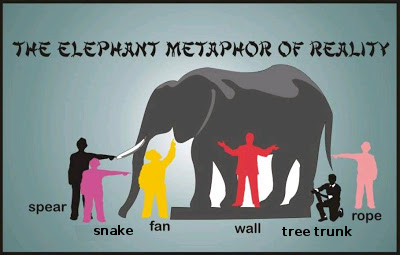
(Click to see their view of reality)
by John P. Pratt
4 Jan 2020, 1 Monkey (SR), Atonement (UH), Priesthood (S), Prophet (US)
©2020 by John P. Pratt. All rights Reserved.
|
1. Seven Chief Angels 2. Elijah & J. Baptist 3. Nephi & Moroni 4. Leah & Rachel 5. Mary Whitmer 6. Conclusion Notes |
The recent awareness among many of the truth of multiple mortal probations is a game changer in the understanding of many aspects of the gospel. One of the most interesting is that there are apparently two distinct levels of where individuals are in their progression. From the Book of Abraham, it is learned that before this world was created, there were two levels of people to come to earth: (1) intelligences and (2) spirits and souls from whom spiritual leaders on earth were chosen (Abr. 3:22-23). That is, the intelligences include all of them, and among them there were some spirits and souls who would become leaders. The spirits (of just men made perfect) and souls differed from each other in that the souls already had a resurrected body (D&C 88:15). The souls are called "angels" (D&C 129:1-3). The ones who were only intelligences needed to come to earth to get both a body and a psyche (translated "soul" in the King James Bible) to be proven to see if they would keep the commandments, whereas the other group was coming back to a mortal existence in order to help others in their progression, with the incentive to improve their own situation (Heb. 11:35) by ascending Jacob's ladder (Gen. 28:12).
 |
There are seven chief angels of God, who have been symbolized as the seven spirits around His throne (Rev. 4:5). They are often called archangels but the Lord seems to reserve that title only for Michael (D&C 88:112, D&C 107:54, D&C 128:21), the president of the seven (D&C 107:93-94), so in my work they have been called the seven chief angels.
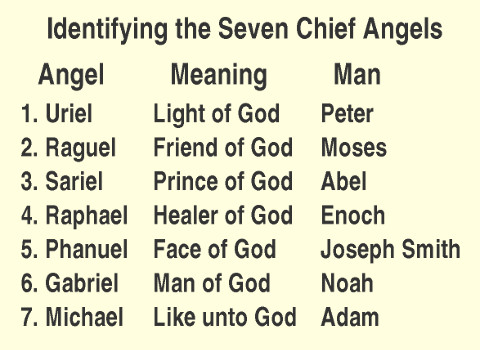 |
While Table 1 may indeed reflect what was a major role of each angel during their mortal probation, it assumes that each angel only had one lifetime on earth. Now that the Doctrine of the Eternal Round is becoming better understood, it appears that each angel might have lived through several probations on earth. There could be at least three different reasons for this.
First, one reason for living in multiple probations is to complete work started in earlier lives. This concept was taught by early LDS Church leaders. For example, Apostle Heber C. Kimball compared several days of a man continuously working on a project to several successive probations of the same person working on a project:
"What I do not today, when the sun goes down, I lay down to sleep, which is typical of death; and in the morning I rise and commence my work where I left it yesterday. That course is typical of the probations we take." -- p. 62 (JD 4:329).
Second, another reason to condescend to live again could be to ascend another rung on Jacob's Ladder of spiritual progression (Gen. 28:12).[3]
Third, an angel might wish to return again to serve in a minor role just to be part of the action of spreading the gospel. That especially applies to these last days, which the fathers have looked forward to when so much new knowledge would be revealed for the first time (D&C 121:26-27).
This section originally was going to simply go through the list of seven angels to speculate what other men might have been a separate mortal probation of those seven angels. As the research progressed, a pattern was discovered which allows much more than speculation, so this subject shall be covered in depth in a future article. The main point to understand here is that each of the seven angels might have lived several other mortal lives, and hence should perhaps be referred to by the angel names, rather than assuming that they had only one mortal life. That concept might explain why the Book of Enoch does not identify any human with an angel: the angel could perhaps be several men!
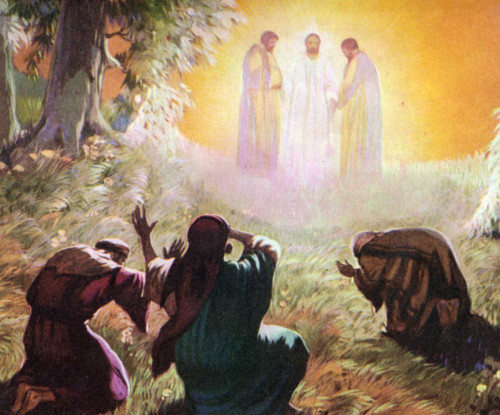 |
The statements are best recorded by Matthew. Unfortunately the King James version (KJV) of the Bible does not usually translate Old Testament names the same in the New Testament. For example, Noah becomes Noe (Mat. 24:38-39), Jonah becomes Jonas (Mat. 12:40), and Elijah becomes Elias (Luke 4:25-26). It is this latter pair which has added to the confusion. Here is the account, where for clarity the KJV "Elias" is replaced with "Elijah" as in nearly all other translations:[4]
And after six days Jesus taketh Peter, James, and John his brother, and bringeth them up into an high mountain apart, And was transfigured before them: and his face did shine as the sun, and his raiment was white as the light. And, behold, there appeared unto them Moses and Elijah talking with him....
And as they came down from the mountain, Jesus charged them, saying, Tell the vision to no man, until the Son of man be risen again from the dead. And his disciples asked him, saying, Why then say the scribes that Elijah must first come? And Jesus answered and said unto them, Elijah truly shall first come, and restore all things. But I say unto you, That Elijah is come already, and they knew him not, but have done unto him whatsoever they listed. Likewise shall also the Son of man suffer of them. Then the disciples understood that he spake unto them of John the Baptist. -- Mat. 17:1-3, 9-13
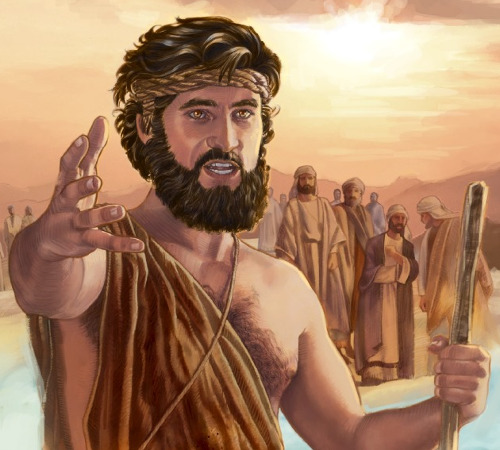 |
Jesus replied that the scripture is indeed correct that Elijah would come before Him. He did not want to explain that the scripture in Malachi actually will have two fulfillments, one at His first coming and one at the Second Coming. The question was about His first coming, so his answer was only about that. He explained that actually Elijah had indeed preceded Him, preparing the way for Him, in the person of John the Baptist! They understood that correctly because Jews at that time were somewhat familiar with multiple probations.
Note the importance of the Savior's explanation. At the first coming of the Messiah, Elijah would actually come in two different ways. First, the spirit of Elijah (meaning the actual spirit, or overself[5], which had controlled the body of the prophet Elijah) would be born again into another mortal probation, becoming a man called John the Baptist, who would prepare a people to receive the Son of God. Second, the actual man Elijah the Prophet, who had lived long ago and had been translated so he still retained that same body, also appeared later on the mount with Moses. They apparently gave some important priesthood keys to Peter, James, and John. After all, Jesus had just recently told Peter that he would be given the keys to the kingdom of heaven (Mat. 16:18-19), so it is likely that it happened on the mount. In fact, not only was Peter given keys, but it is likely that James and John were both also given other priesthood keys. After all, Moses held some keys, but Elijah likely held others.
Perhaps we can expect that at the Second Coming that similar events will occur. There could be a man born with the literal spirit of Elijah who will help prepare a people to receive the Savior, but also the prophet Elijah will also appear in a temple to turn the hearts of the children to the patriarchal fathers, such as Abraham, Isaac, and Jacob.
On Sun 3 Apr 1836, Elijah appeared in the Kirtland Temple with the purpose of fulfilling the prophecy of Malachi and bestowing the keys of turning the hearts of the children to the patriarchs:
After this vision had closed, another great and glorious vision burst upon us; for Elijah the prophet, who was taken to heaven without tasting death, stood before us, and said: Behold, the time has fully come, which was spoken of by the mouth of Malachi--testifying that he [Elijah] should be sent, before the great and dreadful day of the Lord come--To turn the hearts of the fathers to the children, and the children to the fathers, lest the whole earth be smitten with a curse--Therefore, the keys of this dispensation are committed into your hands; and by this ye may know that the great and dreadful day of the Lord is near, even at the doors. -- D&C 110:13-16
Unfortunately, the fulness of the priesthood was lost, but fortunately, Joseph was told to build the Nauvoo temple so that it could again be restored (D&C 124:28, 40-41). But unfortunately, that temple was never completed, so the fulness of the priesthood has not yet been restored.
Thus, we again wait for Malachi's prophecy to be fulfilled again, probably like it was at the time of Christ, because that fulfillment was actually a forerunner of the larger fulfillment in the last days "before the coming of the great and dreadful day of the Lord". That is, it may well be that we await another man to be born with the spirit of Elijah as a new mortal probation in order to prepare the way for the Second Coming. Moreover, we also await the completion of a temple high on a mountain top (Isa. 2:2-3) where the Prophet Elijah can again come to restore the sealing power of the patriarchal priesthood, so that the covenant people may indeed be sealed into the patriarchal family of God!
.jpg) |
The almost universal conclusion of Mormon apologists is that one of the two names was a scribal mistake which got perpetuated. Some researchers have concluded that Nephi is the earlier and correct name, whereas others have argued that the early mistake was corrected in the final history produced by Joseph Smith.[6]
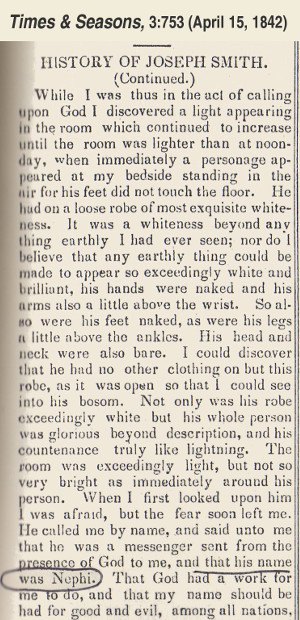 |
One complaint against the 1835 section just quoted from the 1835 Doctrine & Covenants (now D&C 27:5) is that it comes from a part of the revelation which was expanded from the original revelation by Oliver Cowdery, which to some suggests that it came from man and not from God. What if that conclusion is false and that it did indeed come from God?
In 1831 Oliver was called by the Lord to assist William W. Phelps in the preparation for the printing of the Book of Commandments. His part would be "to copy, and to correct, and select, that all things may be right before me, as it shall be proved by the Spirit through him." (D&C 57:11-13). He had also been called to write revelations, such as D&C 20 (D&C 20:16), as long as he did not write commandments (D&C 28:1,4-5).
After returning to Kirtland, Oliver continued in an expanded role in the printing office in the preparation of the Doctrine & Covenants in 1835 (D&C 104:29-32). No one at the time had any problem with Oliver having expanded some of the revelations to include important items which were not found elsewhere in LDS writings, such as the ordination of Joseph and Oliver to be apostles of Jesus Christ by Peter, James and John, to which he was an eyewitness. Oliver knew that he could only write that which was sacred when it was given to him by the Lord (D&C 9:9).
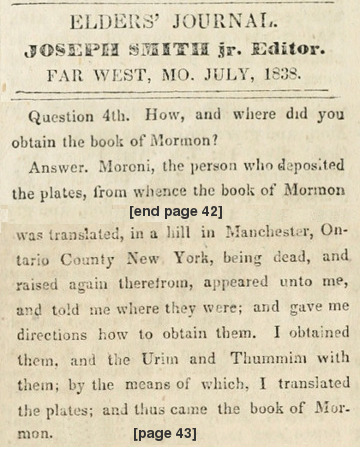 |
Now, in the light of knowledge of multiple mortalities, a new explanation suggests itself. The teachings state that often a man will return in a new probation in order to finish a work he began earlier. That sounds like a perfect match for Nephi beginning a sacred record, and then returning as Moroni to finish it!
It would make perfect sense for the angel to identify himself as Nephi at first because the record begins talking about Nephi. It is here proposed that what the angel actually said on that first visit was that his name was Nephi. Then after the book was finished being translated and the plates were returned to the angel assigned to keep them, Joseph might well have learned about multiple probations and that the angel had also lived as the prophet Moroni. It would then be known that the reason that the angel had charge of the plates was that he had been Moroni, who had buried them. Thus, when Joseph later referred to the custodian of the plates, he used the name Moroni, which made much more logical sense, given the entire history of the Plates of Mormon.
Thus, the best explanation of why Joseph referred to the angel both as Nephi and Moroni is apparently that the same man had lived both as Nephi and as Moroni.
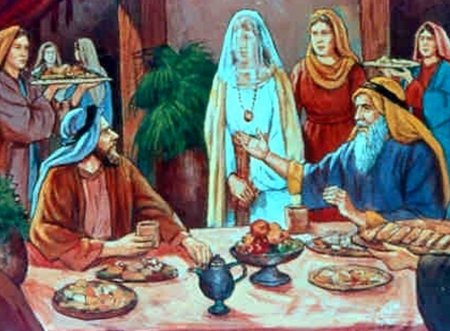 |
For example, consider their marriage dates. Leah was married to Jacob first on the day that had been planned for Rachel's wedding to him, so Rachel was married 7 days later to Jacob. So did Rachel get cheated out of a great marriage date? It turned out that the two women were married on the first and last days of Passover on the Enoch Calendar, on the Uniform Enoch Calendar they were married on the first and last days of the Festival of Lights (Hanukkah), on the Star Calendar the marriages were on Passover and Easter, and on the Uniform Star Calendar they were married on the first day of the Sea-Goat (Capricorn) and first day of the Waterman (Aquarius). That latter coincidence is especially rare because the first days of most zodiac constellations are either four or five weeks apart, but those two are only a week apart because the Waterman has his left arm extended above the Sea-Goat. So what is going on that their two wedding dates so amazingly linked on sacred calendars?
They both also died very young (Leah at age 50, Rachel 48) compared to their husband Jacob (147), and on days which were holy days on at least 10 sacred calendars, including the newly discovered Ventury Toltec Calendar.[7]
There is no other case known in my research of almost exaggerated equality of holiness of key vital dates. What might be the reason for that?
Knowing about multiple mortalities might provide the key to understanding what is going on with Leah and Rachel. In an earlier article about the mechanics of multiple mortalities, it was noted that the same spirit (overself) can control two mortal bodies at the same time; that is, the multiple probations can be concurrent. There was a section discussing how this can explain the amazing coincidences in the lives of identical twins separated at birth.[8] Note, however, that it is not necessary for the two mortals to be twins, let alone identical twins. The latter just makes it interesting for the spirit who wants to compare two contrasting environments given the same physical characteristics. It also makes it easier for scientists to discover that there is something about their lives that needs to be explained.
Leah and Rachel were twins, but were they identical twins? An argument favoring identical is that Jacob could not tell them apart at his wedding. That, however, could be explained by some wine and a veil, and there are reasons why they were probably not identical. There are two likely purposes for the same spirit (overself) to manifest as these two twins. First, they were to be mothers of eight of the twelve tribes of Israel, which would all need to have very different genetic traits so it would be good to have a bigger gene pool.
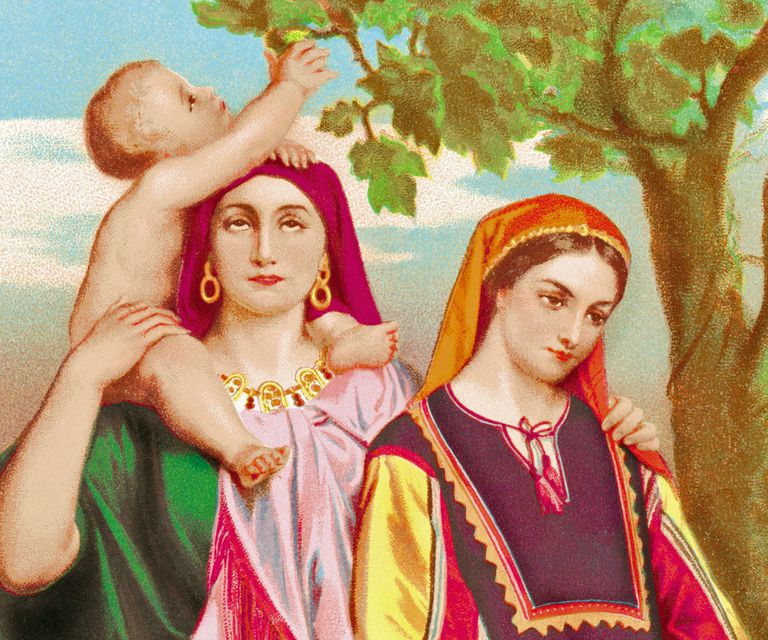 |
Thus, it is here proposed that Leah and Rachel were two separate probations of the same woman! That would indeed explain many things, including why the dates of key sacred events in their lives occurred on such equally matched holy days. It also makes the famous love story of Jacob and Rachel much more interesting!
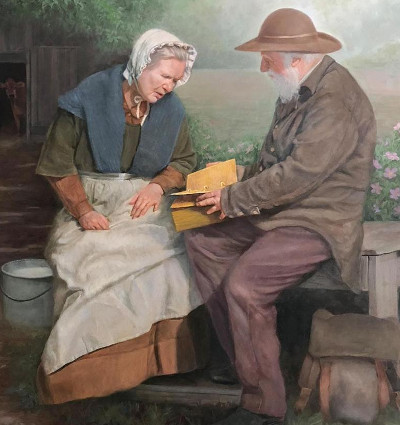 |
There is something else remarkable about Mary Whitmer in addition to having six of the official witnesses of the Book of Mormon in her family. Mary was actually the first witness of the gold plates! The angel, whom she reportedly called "Brother Nephi",[9] showed her the plates as a reward for having accepted the burden of the extra people in the home. Note that her calling him Nephi supports the above conclusion that "Nephi" is indeed what the angel called himself at that time while the book was still being translated.
This story about Mary Whitmer has been so overlooked, compared to all of the official witnesses, that most readers of this article will not be familiar with it at all. It has never seemed to fit in with the narrative because it did not fit the commandment of absolute secrecy from everyone. Oliver Cowdery had not seen the plates at first even though he was the scribe for the translation mentioning that there would be other witnesses. Neither had Joseph's wife Emma seen them, even though she had also undergone many hardships because of the work. What made Mother Whitmer so special?
Mary Whitmer was finally commemorated in a beautiful painting of the plates being shown to her (see Figure 4). At its unveiling, Lynne H. Wilson summarized the importance of Mary's witness thus, "It's easy to remember the three first witnesses: Mary the Virgin, Mary Magdalene, and Mary Whitmer."[10]
So just who was Mary Whitmer really? Many advanced souls condescend to help out with spreading the gospel and they often don't need to play a major role which draws attention to themselves. It is here seconded that, as Lynne Wilson quipped, she indeed deserves to be grouped with those other two Mary's. In particular, in an earlier probation she might have been Leah and Rachel, the mothers of eight of the twelve tribes, even as Mother Whitmer was mother to so many of the witnesses of the Book of Mormon. Perhaps she was one of the Marys who saw the resurrected Lord, such as Mary, the mother of James the Less, who was also a witness of the risen Savior (Mark 15:40, Luke 24:10). In any case, it may well be that she would be comfortable in that kind of company.
Mother Whitmer is an example of the greatest person being the one who serves. She is totally in the background, overlooked as a great leader, but she was probably a more advanced soul than any of her children, who were allowed to be in the limelight. It is often this way in a presidency, where the counselors were greater than the leader, being there to help the leader advance by giving good counsel.
The purpose of offering this suggestion is that knowing about multiple probations opens the door to understanding many mysteries, such as why Mary Whitmer was chosen to see the gold plates when they were under a commandment of strict secrecy.
This article explores the possibility that angels may have come to live more than one mortal life on earth in order to serve more fully. First, the seven chief angels were considered but the results became so numerous as to merit a separate later article.
The clearest example from the Bible was then discussed, being that John the Baptist actually had the literal spirit of Elijah. Because Elijah is called "Elias" in the King James Bible, that has sometimes been understood to define a "spirit of Elias" to mean having the job as being a "forerunner" to prepare the way for someone greater. That may well also be true, but it is now seen to have the literal meaning that the spirit within John was the same spirit that had been in Elijah!
Then other more speculative examples were proposed. First, it was suggested that the resolution to question of whether the angel who revealed the gold plates to Joseph Smith was Nephi or Moroni is easily resolved by understanding that both were really the same angel who had lived as both men. That agrees with the teaching of early Mormon leaders that a man often comes back to finish a work left unfinished in a former life.
Then the puzzle about why the key sacred dates in the lives of Leah and Rachel were so similar can be explained by them both actually being the same spirit being incarnated as (controlling the bodies of) both women. As explained in an earlier article, this is often the case with identical twins, who wish to experience life with a major difference. In this case the difference was that Rachel was beautiful and Leah was less attractive.
Lastly, the case of an angel coming to serve in a little noticed position was given. The case was that of Mary Whitmer, the first witness of the gold plates and mother of several of the male witnesses. It was suggested that she was really a prominent female figure from history who was an important mother, such as Leah/Rachel or one of the famous Marys.
Thus, many puzzling details of religious history can be much more easily understood by realizing that the same spirit can be incarnated into a mortal life several times, possibly even concurrently. All of this greatly expands the light of understanding of the marvelous plan of salvation prepared for us by a loving Heavenly Father!